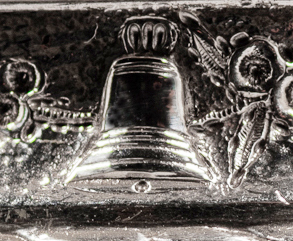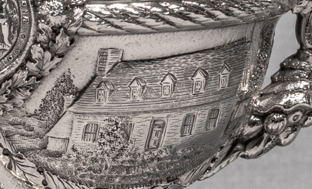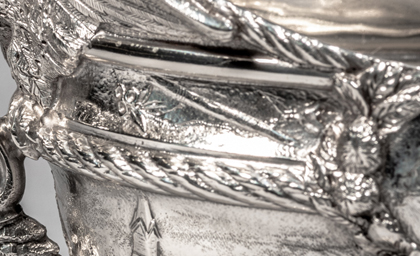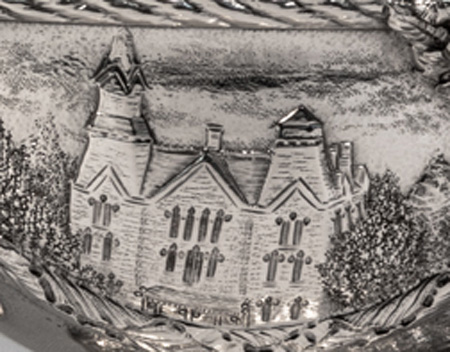Sauce Boat & Ladle, Wicomico County
From the USS Maryland Silver Service

Maker: Samuel Kirk & Sons (1815-1979)
Objects: Sauce Boat and Ladle, Wicomico County
Date: 1906
Medium: Sterling Silver
Dimensions: Sauce boat: Overall height, 7"; Overall width, 7 3/4", Overall depth, 4 1/4"”
Dimensions: Ladle: Overall length, 8 1/8" Overall width, 2 1/4"
Accession number(s): MSA SC 1545-0941-1 (boat) and MSA SC 1545-0941-2 (ladle)
The USS Maryland silver service includes a pair of sauce boats and ladles representing Wicomico and Somerset Counties. Wicomico County was created from Somerset and Worcester counties in 1867. It was named after the Wicomico River from the Native American words "wicko" and "mekee" meaning, "a place where houses are built."
While the seven scenes on each sauce boat are unique to that particular county, the overall appearance of each piece is identical. This sauce boat is decorated with scenes that relate to the early history of the city. Each piece has four main scenes that are separated by festoons of tobacco leaves, while the “border of progress” surrounds the upper portion of the bowl. The Great Seal and the Cruiser are each surrounded by sprays of native trees. The handle terminates in a cornucopia, while an eagle in relief extends out of the upper portion. Oyster shells around the base connect the pieces to the Eastern Shore, and the rope borders symbolize the nautical theme of the service.
The handle of the ladle is formed from a reproduction of a “crownstone” marker of the Mason-Dixon Line. These large limestone markers were placed every five miles along the Mason-Dixon Line, and were decorated with the coats-of-arms of Maryland and Pennsylvania.
Visible scenes (left to right, top to bottom):1. First Telegraph Set (number 89)
The original transmitting and receiving sets are now at the Smithsonian Institute and are also depicted on pieces from Baltimore City and Baltimore, Calvert, Charles, Somerset, and St. Mary’s counties.

3. Cokesbury Bell (number 87)
In 1888, the historic Cokesbury Bell was transferred to Goucher College, then in Baltimore City, and it remained with Goucher College until 1959 when it was presented to the Wesley Theological Seminary in Washington, D.C. The bell is also depicted on the pieces from Somerset, St. Mary’s, and Charles counties.

On St. Bartholomew's Day, August 24, 1887, the church was reconsecrated and named St. Bartholomew's. It no longer holds regular services and is not open to the public, however, services are still held in the church once a year on August 24th.
![Greenhill Church [Saint Bartholomew’s Church]](images/uss_md_83_84.jpg)

Scenes on the reverse (left to righ, top to bottomt):
1. First Steel Pen (number 88)
The first steel pen is also depicted on pieces from Charles, Somerset, and St. Mary’s counties.

3. First Telegraph Set (number 89)
The original transmitting and receiving sets are now at the Smithsonian Institute and are also depicted on the pieces from Baltimore City and Baltimore, Calvert, Charles, Somerset, and St. Mary’s counties.


The Cokesbury Bell came from Cokesbury College, the first Methodist college on the American continent. In 1789, when George Washington was heading to New York for his inauguration the bell was rung in his honor as he passed by. In 1795 the tower that housed the bell was deliberately set on fire, and everything was lost, except for the bell which was completely unharmed. In 1888 the historic Cokesbury Bell was transferred to Goucher College in Baltimore City and it remained until 1959 when it was presented to the Wesley Theological Seminary in Washington, D.C. The bell is also depicted on the St, Mary’s County Water Pitcher and the Charles County Cream Pitcher.

5. Green Hill Church [Saint Bartholomew’s Church] (number 84)
Two views of the same historic church are depicted on the sauce boat. Green Hill Church was constructed and opened in 1733 and was listed on the National Register of Historic Places in 1973.
On St. Bartholomew's Day, August 24, 1887, the church was reconsecrated and named St. Bartholomew's. It no longer holds regular services and is not open to the public, however, services are still held in the church once a year on August 24th.
![Greenhill Church [Saint Bartholomew’s Church]r](images/uss_md_83_84.jpg)
|
This web site is presented for reference purposes under the doctrine of fair use. When this material is used, in whole or in part, proper citation and credit must be attributed to the Maryland State Archives. PLEASE NOTE: The site may contain material from other sources which may be under copyright. Rights assessment, and full originating source citation, is the responsibility of the user. |
© Copyright August 07, 2024 Maryland State Archives
